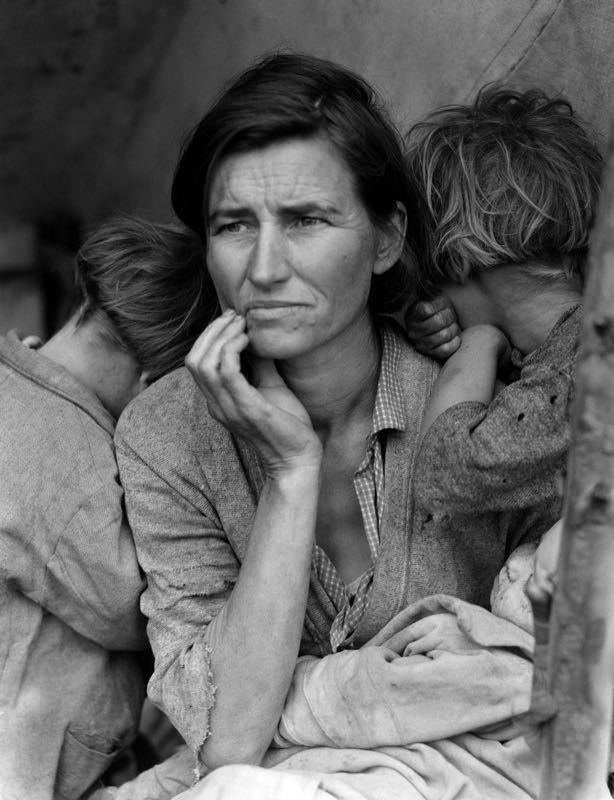Influential Female Photographers Who Have Made History
GearFocus
Mar 19, 2021

DOROTHEA LANGE
 Dorothea is one of the most influential female photographers who have made history. Tragic events and periods in history remain overlooked. However, her photographs visualize and humanize the fear and pain in victims. In 1936, photographer Dorothea Lange captured a mother's image (Florence Owens Thompson) and her children living in poverty. This work became one of the most important images of the Great Depression. Nonetheless, it has become an infinitely reproduced symbol of courage and endurance.
Migrant Mother remains the most enduring image of the Great Depression and is now one of the most famous photographs ever made. As a result, the photo prompted the government to respond to prevent starvation at the camp. The photo was shown at the Museum of Modern Art’s first photography exhibition in 1940. Through extensive reproduction, her work became a symbol of endurance to motivate and inspire Americans in a way that words simply cannot.
Dorothea is one of the most influential female photographers who have made history. Tragic events and periods in history remain overlooked. However, her photographs visualize and humanize the fear and pain in victims. In 1936, photographer Dorothea Lange captured a mother's image (Florence Owens Thompson) and her children living in poverty. This work became one of the most important images of the Great Depression. Nonetheless, it has become an infinitely reproduced symbol of courage and endurance.
Migrant Mother remains the most enduring image of the Great Depression and is now one of the most famous photographs ever made. As a result, the photo prompted the government to respond to prevent starvation at the camp. The photo was shown at the Museum of Modern Art’s first photography exhibition in 1940. Through extensive reproduction, her work became a symbol of endurance to motivate and inspire Americans in a way that words simply cannot.
Lorna Simpson
 Twenty Questions 1986[/caption]
Twenty Questions 1986[/caption]

What better way to celebrate feminism than with black female photographers? Lorna Simpson is one of the most influential female African-American photographers in history. Lorna Simpson is based in New York City. She earned her BFA from The School of Visual Arts. She later received her MFA from the University of California, San Diego. Her work involves media such as photography, film, silk screening, and two-dimensional photography. The work often focuses on multiculturalism, race, gender identity, and all of these elements intersectionality. Most importantly, her work teaches people how minorities were being affected by institutional racism.
Simpson's work has been published in several national and international exhibitions. Much of her work, such as Guarded Conditions and Square Deal, are touchstones for discussing the female African-American experience. Nonetheless, her work is the little-mentioned narrative of black bodies in America. Lorna's notarized for her ability to expose how mistreatment towards blacks. Therefore, it is still a cause for tension. Most importantly, what many people try to ignore, Simpson makes impossible to look away from. She used different media to illustrate the treatment of minorities. She exposed the media for negatively characterizing minorities.
Diane Arbus

 Diane Arbus is one of the most well-known American photographers of the 20th century. In 1960, Arbus received two Guggenheim Fellowships to support her work. She began a teaching career at the Parsons School of Design and the Rhode Island School of Design. Firstly, known for her striking black and white photographs. Secondly, known for her photos of children, artists, famous figures. But more importantly, she highlighted the importance of proper representation of all people.
Diane Arbus is one of the most well-known American photographers of the 20th century. In 1960, Arbus received two Guggenheim Fellowships to support her work. She began a teaching career at the Parsons School of Design and the Rhode Island School of Design. Firstly, known for her striking black and white photographs. Secondly, known for her photos of children, artists, famous figures. But more importantly, she highlighted the importance of proper representation of all people.
 In the early 1960s, Arbus began producing portraits of people on society's outskirts. These works include clowns, exotic dancers, circus performers, and transgender people. She received great recognition for taking risks within these works. Arbus also became known for her eerie photographs of children, intimate portraits of famous figures, and urban scenes.
In the early 1960s, Arbus began producing portraits of people on society's outskirts. These works include clowns, exotic dancers, circus performers, and transgender people. She received great recognition for taking risks within these works. Arbus also became known for her eerie photographs of children, intimate portraits of famous figures, and urban scenes.
Lorraine O’Grady
 Lorraine O'Grady is an American artist Critic based in Boston, Massachusetts. O’Grady worked in performance, photo installation, video, and photomontage, exploring gender, diaspora, identity, and aesthetics. She is known for performance works "Mlle Bourgeoise Noire" and "Art Is." As well as her latter performance in Harlem’s African-American Day Parade. In this performance, O’Grady positioned a giant, antique-style gold frame atop afloat so that, in the spirit of celebration and inclusivity, it framed everything it passed as art.
Lorraine is one of the most influential Female Photographers who have made history within the feminist movement of 1970. She has addressed diaspora, hybridity, and black female subjectivity within her work. Lorraine has also emphasized the formative roles these have played in the history of modernism. O'Grady's work uses different media, including text, photo-installation, video, and performance. Within her work, you will also see how multiple emotions and ideas coexist. In 2016, O'Grady was quoted saying;
Lorraine O'Grady is an American artist Critic based in Boston, Massachusetts. O’Grady worked in performance, photo installation, video, and photomontage, exploring gender, diaspora, identity, and aesthetics. She is known for performance works "Mlle Bourgeoise Noire" and "Art Is." As well as her latter performance in Harlem’s African-American Day Parade. In this performance, O’Grady positioned a giant, antique-style gold frame atop afloat so that, in the spirit of celebration and inclusivity, it framed everything it passed as art.
Lorraine is one of the most influential Female Photographers who have made history within the feminist movement of 1970. She has addressed diaspora, hybridity, and black female subjectivity within her work. Lorraine has also emphasized the formative roles these have played in the history of modernism. O'Grady's work uses different media, including text, photo-installation, video, and performance. Within her work, you will also see how multiple emotions and ideas coexist. In 2016, O'Grady was quoted saying;

Anna Atkins
 One of the very first female photographers who have made history is Anna Atkins! She was an English botanist and illustrator. Akins is one of the most influential women who have made history. Atkins learned about photography from the famous William Henry Fox Talbot. In 1839, he introduced Anna to photogenic drawing. In 1941, she used it to illustrate her first book. Anna later learned about the cyanotype process from John Herschel. This led her to publish five fictional novels between 1852 and 1863.
One of the very first female photographers who have made history is Anna Atkins! She was an English botanist and illustrator. Akins is one of the most influential women who have made history. Atkins learned about photography from the famous William Henry Fox Talbot. In 1839, he introduced Anna to photogenic drawing. In 1941, she used it to illustrate her first book. Anna later learned about the cyanotype process from John Herschel. This led her to publish five fictional novels between 1852 and 1863.
Why Celebrate Women?
Photography is no longer a men’s field. However, female photographers still have a hard time making their way in the industry and gaining the credit they deserve. We are here to highlight how many excellent women have left their mark in the photography world. These ladies are only a few of the many more outstanding female photographers who have influenced photography. Women deserve appreciation and notoriety in the photography industry. Women have been using photography as an art form to represent an expression visually. As creative people, we need to recognize the work and efforts of female photographers. Now that we have provided you with some great food for thought, we would love to hear your views, ideas, and opinions!Own one like this?
Make room for new gear in minutes.